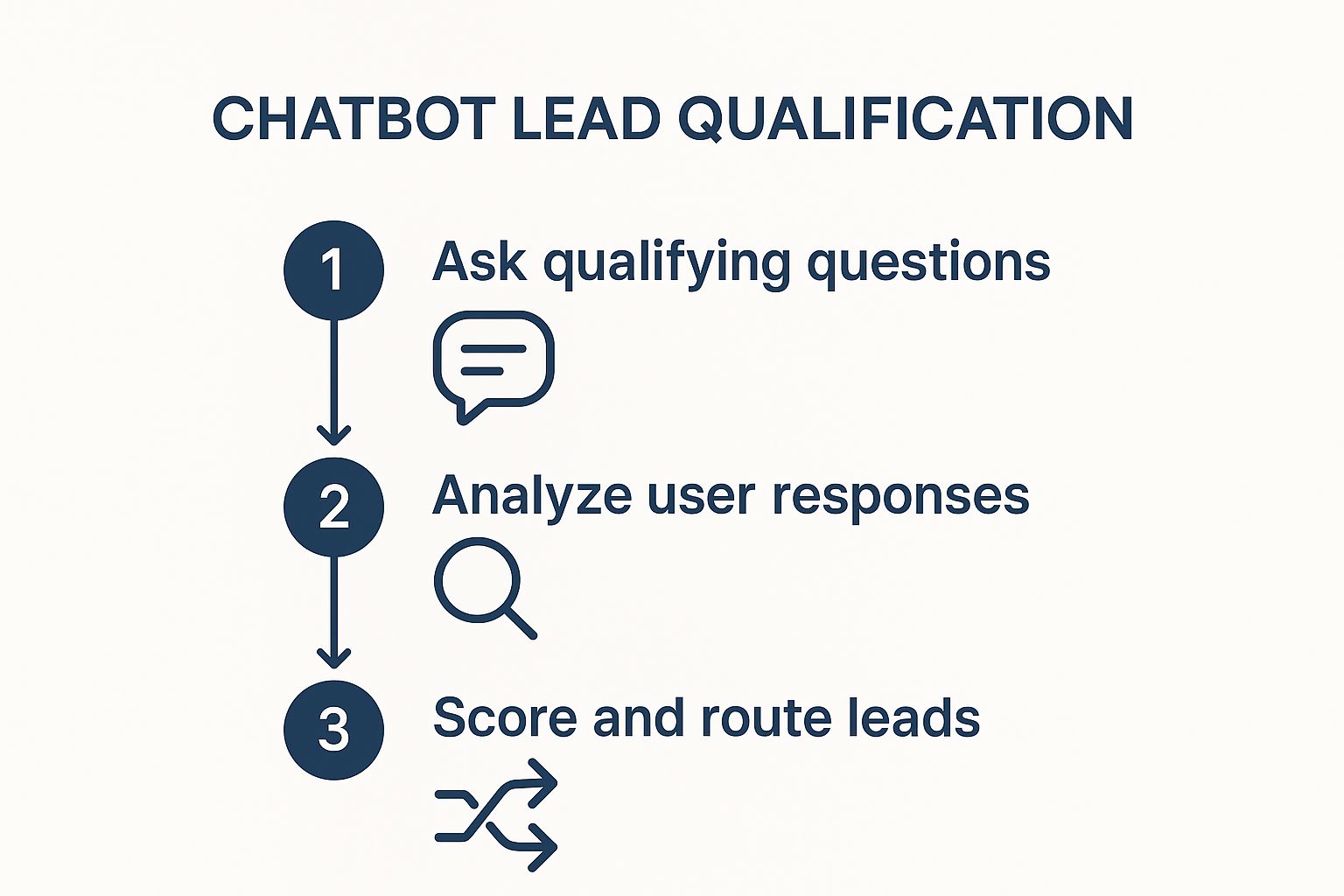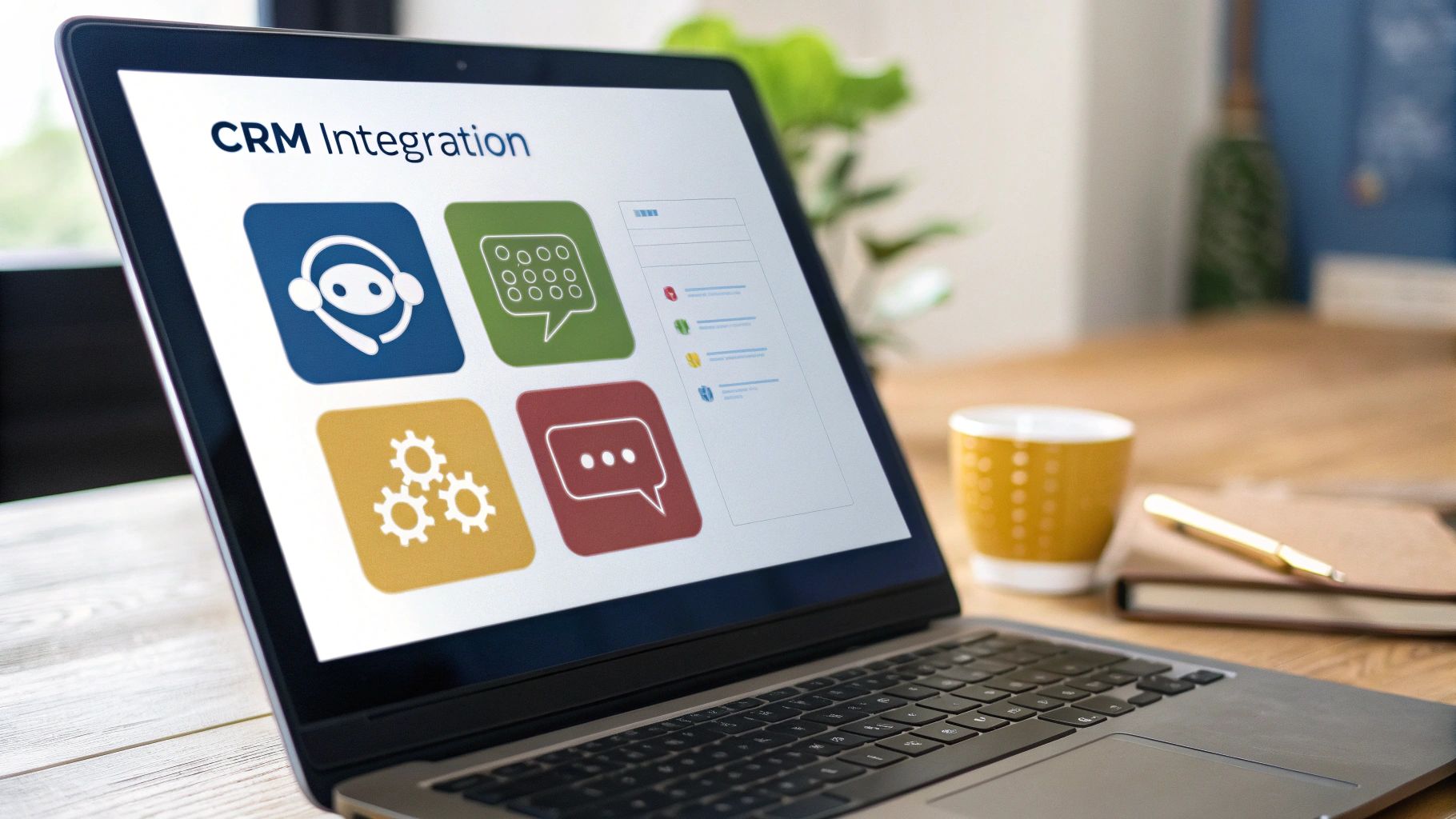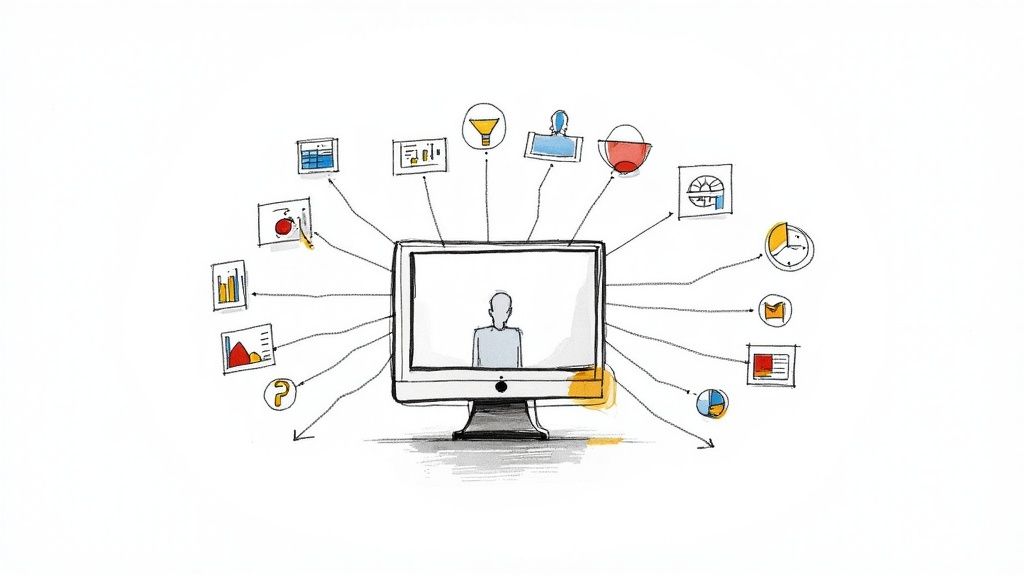How Do Chatbots Qualify Leads? A Practical Guide
Chatbots are more than just a pop-up window on your website. They are revolutionizing how businesses interact with potential customers, turning a passive website visit into an active, helpful conversation. By asking smart questions in real-time, chatbots engage visitors, gather crucial information, determine their intent, and instantly sort them into the right sales funnels. This guide explains exactly how chatbots qualify leads and why this method is a game-changer for your sales team.
How Chatbots Are Reinventing Lead Qualification
Think about the classic "Contact Us" form. It's a one-way street. Someone fills it out, hits submit, and then... they wait. This old-school method leads to a high abandonment rate. Your sales team ends up with a giant list of unfiltered contacts, and they have to waste valuable time sifting through them to find out who is actually a good fit.
Chatbots flip this entire process around by starting a real, two-way dialogue the second someone lands on your site. They work like a 24/7 digital concierge, ready to greet every single visitor, answer their basic questions, and gently guide the conversation toward qualification. This immediate, personal touch is the heart of conversational marketing, a strategy built on creating relationships through these kinds of instant interactions.
From Passive Forms to Active Conversations
At its core, a lead qualification chatbot is designed to collect the same information a form would—name, email, company, needs—but it does so in a way that feels natural and human. Instead of hitting someone with a wall of empty fields, the bot asks questions one by one. It feels less like paperwork and more like a helpful chat.
This conversational approach has some serious perks:
- Less Friction for Visitors: Asking for information in small, bite-sized pieces makes the whole process feel easier and less intimidating.
- On-the-Spot Segmentation: The bot can instantly figure out who it's talking to based on their answers. Is it a student doing research? A small business owner? A decision-maker at a huge company? The bot knows.
- Immediate Action for Hot Leads: High-value prospects don't have to wait around. The chatbot can book a demo on the spot or connect them directly with a live sales rep, striking while the iron is hot.
Turning data collection into a service-oriented conversation doesn't just get you information; it improves the entire user experience. You start building trust from the very first click, which sets your sales team up for a much warmer conversation down the line.
To really see the difference, let's put them side-by-side.
Chatbot Qualification vs Traditional Forms
As you can see, it’s not really a fair fight. Chatbots provide a dynamic experience that modern buyers have come to expect.
The Impact on Sales Efficiency
The results speak for themselves. Businesses that use AI chatbots for qualification often see a threefold increase in sales conversions compared to just using website forms. Why? Because a well-programmed chatbot can help turn nearly 28% of all website visitors into qualified leads.
It works because it's a seamless, instant experience. By handing your sales team a pipeline of pre-vetted prospects who have already raised their hand, you empower them to stop chasing cold leads and start focusing on what they do best: closing deals.
Crafting Your Lead Qualification Conversation

The real magic of a chatbot isn't just that it can talk; it's how it talks. The difference between a bot that feels genuinely helpful and one that’s just a clunky, robotic form is all in the conversational design. A great qualification flow doesn’t just pull data from a visitor—it guides them, answers their immediate questions, and makes them feel like you actually get their problem.
Think of your chatbot as the most helpful person on your team, available 24/7. It's the one who greets people at the door, figures out what they need, and introduces them to the right specialist. It all starts by turning your Ideal Customer Profile (ICP) into a smart, natural-sounding dialogue.
First, Know Exactly Who You're Looking For
Before you write a single line of script, you need to be laser-focused on who you want the chatbot to find. What specific traits turn a random website visitor into a high-potential lead for your sales team? This means mapping out the exact data points that separate the "just browsing" crowd from your future customers.
Here are the core pillars to focus on:
- Firmographics: The hard facts about their company. Think company size, industry, and perhaps annual revenue.
- Role & Authority: Who are you actually talking to? Is it a decision-maker with buying power, an influencer, or an end-user who will champion your product internally?
- Pain Points & Needs: This is the big one. What specific problem are they trying to solve? Does it perfectly match the solution you offer?
- Urgency & Timeline: How hot is this lead? Are they looking to buy now or just doing research for a project that’s a year away?
Once you have these criteria nailed down, you can start building questions that get you this information without sounding like a robotic interrogator.
Mix Up Your Questions for a More Natural Flow
The best chatbot scripts are a smart blend of open-ended and closed-ended questions. This is crucial. If you only use one type, the conversation either feels like a rigid, multiple-choice quiz or a vague, aimless chat.
Closed-ended questions are your go-to for collecting clean, structured data. Asking something like, "How many employees are in your company?" with pre-set options like "1-10," "11-50," and "51-200" is perfect. It’s fast for the user and gives you the exact data you need for scoring.
On the other hand, open-ended questions are where you strike gold. A question like, "What’s the biggest challenge you're facing with customer engagement right now?" invites a real, detailed response. This is how you uncover the why behind their visit and find pain points you never even considered.
The art is in the sequence. I’ve found the best approach is to start with broad, easy questions to get the conversation rolling. Once you’ve built a little momentum, you can strategically drop in the more specific qualifying questions. It keeps the user engaged and the conversation moving forward.
These conversations can happen anywhere, and it's smart to think about deploying chatbots on platforms like WhatsApp where your customers are already active.
Real-World Scripting Examples
Let's look at how this plays out in a real scenario.
Scenario: A SaaS Company trying to find Enterprise-level Leads
Imagine a SaaS company that wants its chatbot to filter out small businesses and quickly flag potential enterprise customers. The conversation could go something like this:
The Opener: The bot starts broad and helpful. "Hi there! I can help you get started with a demo or answer any questions. What brings you here today?" This is an open-ended way to see what's on their mind.
Initial Sorting: Let's say the user clicks a button for "Pricing Info." The bot follows up with a simple, closed-ended question: "Got it. To give you the right info, about how many people are on your team?"
The Key Qualifier: If the user selects "500+," alarm bells should go off. This is a potential enterprise lead. The bot digs a little deeper: "Great! Are you looking for a solution for a specific department or something company-wide?"
The Handoff: Based on that final answer, the bot now has everything it needs. It can skip the standard process and immediately route the conversation to a dedicated enterprise account executive.
In just a few quick interactions, the chatbot has successfully identified a high-value prospect and fast-tracked them to sales. That’s efficiency.
Building a Real-Time Lead Scoring Model
So, your chatbot has done its job and gathered some great information. Now what? The real magic happens when you turn that raw conversation into something your sales team can actually use. This is where a real-time lead scoring model comes in. Think of it as a system that instantly grades a lead's potential, all without a human lifting a finger.
We're moving beyond just collecting data points. It’s not enough to know a visitor’s company size; you need to know what that size means to you. For instance, a startup with 10 employees might only get 5 points, but a big fish—an enterprise with over 1,000 employees—could be worth 50 points. You apply this same logic to every bit of information the chatbot uncovers.
Assigning Points to Key Data
To get this right, you first need to pinpoint which attributes actually matter to your business. The goal is to build a scoring system that perfectly mirrors your Ideal Customer Profile. The higher the score, the closer they are to being a dream customer.
You can start assigning points based on a few key areas:
- Firmographic Data: This is the basic company info—size, industry, annual revenue. If a lead comes from one of your target industries, you might give them an easy +20 points.
- Role and Authority: A C-level executive or a VP obviously has more pull than an intern. Their title alone could net them +30 points versus the intern's +2 points, simply because they're the ones who can sign the checks.
- Expressed Need: When a user's answers point directly to a problem your product solves, that's a huge buying signal. It’s a clear sign of a good fit and deserves a healthy number of points.
- Behavioral Cues: What did they do before starting the chat? If they lingered on the pricing page or downloaded a specific case study, that's high-intent behavior. Those actions should definitely bump up their score.
This image gives a great, simplified look at how a chatbot processes this information from start to finish.

As you can see, it’s a logical flow: the bot asks, analyzes the answers against your scoring model, and then routes the lead based on the final score.
Setting MQL and SQL Thresholds
Once you've got your scoring system figured out, you need to set the boundaries. These thresholds are what tell the chatbot what to do next. A really common and effective way to do this is to build your questions around a framework like BANT (Budget, Authority, Need, Timeline). The bot can ask direct questions like, "Do you have a budget set aside for this?" to get the structured data it needs. This information feeds right into the scoring algorithm, giving you an instant assessment.
By setting clear, point-based thresholds, you’re giving your chatbot a data-driven rulebook. It stops guessing and starts making genuinely intelligent routing decisions on its own.
This is what allows you to separate a Marketing Qualified Lead (MQL) from a Sales Qualified Lead (SQL). An MQL might be someone who scores between 40-69—they’re interested, but maybe not quite ready to talk to sales. But an SQL, anyone scoring 70 or higher, is a hot prospect who should be fast-tracked to a sales rep right away.
For a more detailed breakdown, you can check out our guide on lead scoring best practices to really dial in your strategy.
Getting Leads from Your Chatbot to Your Sales Team—Instantly

It doesn't matter how great your chatbot is at qualifying leads if those leads just end up sitting in a spreadsheet somewhere. I've seen it happen too many times—a company builds a brilliant bot, but the handoff to sales is a clunky, manual process. That's where all the momentum dies.
The whole point is to create a smooth, automatic workflow that gets a qualified lead to the next step the second they're identified. This is what separates a decent chatbot from a sales-generating machine. Forget about reps sifting through transcripts or copy-pasting info into a CRM. When the system handles it, your team's response time drops from hours to seconds, and you stop letting good opportunities go cold.
How to Instantly Connect with Hot Leads
When a lead checks all the boxes—right company size, right role, high-urgency answers—you have to act immediately. These are your Sales Qualified Leads (SQLs), and their buying intent is sky-high. Your one job is to get them in front of a human, fast.
Here are the two best ways to do this for those high-value prospects:
- Live Chat Takeover: This is my personal favorite. The chatbot pings an available sales rep, who can see the entire conversation history and seamlessly take over the chat. The prospect gets an expert answer to their complex question without missing a beat.
- Automatic Demo Booking: If someone says, "I'd love to see a demo," the last thing you want is a reply saying, "Great, someone will email you to schedule." Instead, the bot should tap directly into your sales team’s calendars (using a tool like Calendly) and let the lead book a time right then and there.
The magic of an instant handoff is that it strikes while the iron is hot. You’re engaging with someone at their peak moment of interest. When a person is actively asking buying questions, connecting them to a sales rep at that exact moment drastically improves your shot at closing the deal.
What About Leads Who Aren't Ready to Buy Yet?
Of course, not every good lead is ready to pull out their credit card today. You'll get plenty of people who fit your ideal customer profile perfectly but are still in the early research phase. We call these Marketing Qualified Leads (MQLs), and just letting them walk away is a massive missed opportunity.
Instead of pushing them into a sales conversation they aren't ready for, your chatbot's job is to automatically guide them into a nurture workflow. This is just as important for building a healthy sales pipeline for the future.
Let's walk through a real-world scenario.
Imagine a user tells the bot they're a project manager at a 200-person tech company (a great fit!), but their budget for a new tool isn't approved for another 6-12 months. A smart chatbot workflow would instantly do this in the background:
- Create and Tag the CRM Contact: A new contact is automatically created in your HubSpot or Salesforce CRM, tagged as "MQL - Future Project" and "Tech Industry."
- Enroll Them in a Nurture Sequence: The bot adds their email to a specific, long-term email campaign built for tech project managers. Over the next few months, they'll receive helpful case studies and tips, not sales pitches.
This simple automation keeps your brand top-of-mind. You're building trust and providing value, so when they are finally ready to buy, you're the first one they think of.
Taking a Look Under the Hood: Analyzing and Optimizing Your Chatbot’s Performance

Getting your chatbot live isn't the finish line; it’s really just the starting gun. If you want to build a powerful lead qualification engine, you can't treat it like a "set it and forget it" gadget. The real magic happens when you start digging into the data to see how people are actually interacting with it.
This constant cycle of review and refinement is what turns a decent chatbot into a revenue-generating machine. The AI chatbot market is exploding for a reason—it's projected to shoot past $46 billion by 2029. That growth isn't just about simple automation; it's about the deep analytical power these tools offer. You can get the full scoop on this incredible growth and what it means for businesses in the full report on Thunderbit.com. This trend really drives home how vital ongoing optimization is.
Become a Detective: Dive Into Conversation Transcripts
Think of your chatbot’s conversation logs as a treasure map. They're packed with clues that tell you exactly what’s working and what’s falling flat. I make it a habit to regularly review these transcripts because it's hands-down the best way to spot patterns and friction points.
Here’s what I always look for:
- Drop-off Points: Where are people consistently bailing on the conversation? This is a huge red flag. It could point to a confusing question, a technical bug, or a conversational path that just doesn’t make sense for them.
- Repetitive Questions: If you see users asking the same thing over and over in slightly different ways, your bot is failing to deliver a clear answer. This is a golden opportunity to tweak your script or build out a new, more direct conversational flow.
- The Golden Paths: Pinpoint the conversation flows that consistently produce a qualified lead. What questions did the bot ask? What information did the user provide? Your goal is to find out what makes these paths successful and replicate those elements elsewhere.
Your data tells a story. Analyzing where conversations break down is just as important as celebrating the ones that succeed. Every failed interaction is a free lesson on how to build a better experience next time.
Let the Data Decide: A/B Testing Your Way to Better Results
Once you've spotted some areas for improvement, don't just guess at a solution. Test it. A/B testing is your best friend for fine-tuning how your chatbot qualifies leads. You can experiment with small, specific changes and get concrete data on what your audience actually prefers.
Here are a few simple A/B tests you can run right away:
- The Opening Line: Does a friendly, casual opener like "Hey there! How can I help?" work better than something more direct, like "Welcome. Are you looking for product information or support?"
- Question Phrasing: The way you ask a question matters. Instead of a blunt "What is your budget?" try testing a softer approach, like "Are you working with a specific budget range for this project?" You might be surprised by the difference.
- The Call-to-Action: For those hot leads, does "Book a Demo Now" convert better than "Chat with a Specialist"? The right CTA can make or break your handoff success rate.
This whole process of analyzing and optimizing is a core principle of any good automated customer support strategy, not just lead gen. It ensures your system is constantly learning and getting smarter over time.
Frequently Asked Questions About How Chatbots Qualify Leads
Here are answers to the most common questions about using chatbots for lead qualification.
What is the difference between a lead gen and a lead qualification chatbot?
A lead generation chatbot's main job is to capture basic contact info, like a name and email. It’s essentially a conversational "subscribe" form. A lead qualification chatbot goes much deeper. It asks strategic questions about needs, budget, authority, and timeline to determine if a visitor is a good fit for your business, effectively scoring them in real-time.
How technical do I need to be to set up a chatbot?
The tech barrier is much lower than you think. Modern chatbot platforms like Drift or Intercom are built for marketers, not developers. They use no-code, drag-and-drop interfaces, allowing you to build complex conversation flows without writing any code. For most standard CRM integrations like HubSpot or Salesforce, you can handle the entire setup yourself.
Can a chatbot really handle complex B2B lead qualification?
Absolutely. This is where they excel. B2B sales cycles are long and involve many factors. A well-designed chatbot can ask nuanced questions about company size, industry-specific pain points, and existing tech stacks. It can then intelligently route conversations to the correct specialist, filtering out unqualified inquiries so your sales team only engages with high-potential prospects.
Ready to turn your website visitors into qualified leads? Worknet.ai Inc provides the AI-powered chat solution that engages visitors, drives trial conversions, and supports customers for life. See how it works at worknet.ai.
FAQs
.png)
Lorem ipsum dolor sit amet, consectetur adipiscing elit. Suspendisse varius enim in eros elementum tristique. Duis cursus, mi quis viverra ornare, eros dolor interdum nulla, ut commodo diam libero vitae erat. Aenean faucibus nibh et justo cursus id rutrum lorem imperdiet. Nunc ut sem vitae risus tristique posuere.
Lorem ipsum dolor sit amet, consectetur adipiscing elit. Suspendisse varius enim in eros elementum tristique. Duis cursus, mi quis viverra ornare, eros dolor interdum nulla, ut commodo diam libero vitae erat. Aenean faucibus nibh et justo cursus id rutrum lorem imperdiet. Nunc ut sem vitae risus tristique posuere.
Lorem ipsum dolor sit amet, consectetur adipiscing elit. Suspendisse varius enim in eros elementum tristique. Duis cursus, mi quis viverra ornare, eros dolor interdum nulla, ut commodo diam libero vitae erat. Aenean faucibus nibh et justo cursus id rutrum lorem imperdiet. Nunc ut sem vitae risus tristique posuere.
Lorem ipsum dolor sit amet, consectetur adipiscing elit. Suspendisse varius enim in eros elementum tristique. Duis cursus, mi quis viverra ornare, eros dolor interdum nulla, ut commodo diam libero vitae erat. Aenean faucibus nibh et justo cursus id rutrum lorem imperdiet. Nunc ut sem vitae risus tristique posuere.
Lorem ipsum dolor sit amet, consectetur adipiscing elit. Suspendisse varius enim in eros elementum tristique. Duis cursus, mi quis viverra ornare, eros dolor interdum nulla, ut commodo diam libero vitae erat. Aenean faucibus nibh et justo cursus id rutrum lorem imperdiet. Nunc ut sem vitae risus tristique posuere.
Lorem ipsum dolor sit amet, consectetur adipiscing elit. Suspendisse varius enim in eros elementum tristique. Duis cursus, mi quis viverra ornare, eros dolor interdum nulla, ut commodo diam libero vitae erat. Aenean faucibus nibh et justo cursus id rutrum lorem imperdiet. Nunc ut sem vitae risus tristique posuere.
Lorem ipsum dolor sit amet, consectetur adipiscing elit. Suspendisse varius enim in eros elementum tristique. Duis cursus, mi quis viverra ornare, eros dolor interdum nulla, ut commodo diam libero vitae erat. Aenean faucibus nibh et justo cursus id rutrum lorem imperdiet. Nunc ut sem vitae risus tristique posuere.
Lorem ipsum dolor sit amet, consectetur adipiscing elit. Suspendisse varius enim in eros elementum tristique. Duis cursus, mi quis viverra ornare, eros dolor interdum nulla, ut commodo diam libero vitae erat. Aenean faucibus nibh et justo cursus id rutrum lorem imperdiet. Nunc ut sem vitae risus tristique posuere.
Lorem ipsum dolor sit amet, consectetur adipiscing elit. Suspendisse varius enim in eros elementum tristique. Duis cursus, mi quis viverra ornare, eros dolor interdum nulla, ut commodo diam libero vitae erat. Aenean faucibus nibh et justo cursus id rutrum lorem imperdiet. Nunc ut sem vitae risus tristique posuere.
Lorem ipsum dolor sit amet, consectetur adipiscing elit. Suspendisse varius enim in eros elementum tristique. Duis cursus, mi quis viverra ornare, eros dolor interdum nulla, ut commodo diam libero vitae erat. Aenean faucibus nibh et justo cursus id rutrum lorem imperdiet. Nunc ut sem vitae risus tristique posuere.

.svg)


.webp)
.webp)
.webp)





